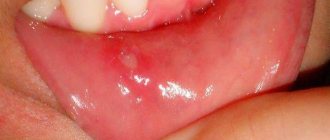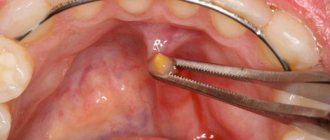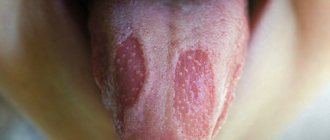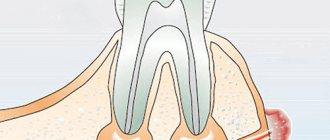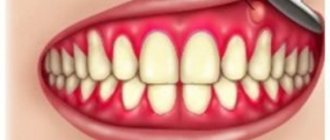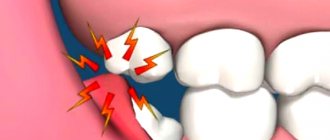Today it has already been proven that lip cancer often develops in smokers. Accordingly, it is this bad habit that is mainly the cause of serious illness. According to statistics, men suffer from lip cancer much more often than women, but this trend is changing all over the world, because many representatives of the fair sex also suffer from tobacco addiction. Among ordinary people, it is customary to talk about the development of lung cancer due to smoking strong cigarettes for a long time, but we all should know that this disease is not the only one that occurs due to bad habits.
Lip cancer - what is it?
Depending on the type of tumor growth, the following forms of lip cancer are distinguished:
- Papillary;
- warty;
- Ulcerative;
- Ulcerative-infiltrative.
A malignant tumor of the lip in 95% of cases is represented by keratinizing squamous cell carcinoma. In 5% of cases, histologists have squamous cell non-keratinizing cancer of the lip mucosa. A tumor of the lip, which from the inside, on the mucous membrane, is characterized by a malignant course (infiltrative growth and early metastasis to regional lymph nodes).
A tumor of the lower lip most often affects the border of the lower lip. A crack, ulcer or swelling forms on it, which looks like a wart. The disease is predominantly diagnosed in people over 60 years of age.
Cancer of the upper lip occurs less frequently than the lower lip, but the tumor is more aggressive. Upper lip cancer has a high risk of metastasis and spreads quickly. This is explained by the fact that the malignant tumor is located close to the nasal cavity, where the blood supply system is developed. A tumor on the inside of the lip is dangerous because it quickly grows into the soft tissue.
Melanoma on the lip is 10 times less common than squamous cell carcinoma of the lip, but is characterized by a high degree of malignancy. Basically, the tumor is located on the red border of the lower lip. It penetrates deeply into tissues, quickly transfers to nearby tissues and gives metastases.
At the Yusupov Hospital, oncologists make a diagnosis of lip cancer using the following methods:
- Examination with the naked eye and using stomatoscopy;
- Cytological examination of impression smears from a tumor ulcer;
- Histological examination of lymph node punctate.
After establishing the primary diagnosis, a comprehensive examination of the patient is carried out.
Make an appointment
Do not delay your visit to a specialist - the sooner the disease is detected, the higher the chances of a full recovery. Onco works on weekends and holidays, so you can schedule a consultation at any time. To do this, use the method most convenient for you:
- call us at our contact number;
- use the online form on the website.
We are located at 2nd Tverskoy-Yamskaya lane, 10, not far from the metro stations “Belorusskaya”, “Novoslobodskaya”, “Mayakovskaya”, “Mendeleevskaya” and “Chekhovskaya”.
Causes of lip cancer
Lip cancer develops for many reasons:
- From smoking;
- After a long stay in the sun;
- As a result of inflammatory processes of an infectious and non-infectious nature;
- Under the influence of high temperatures;
- In the presence of microtraumas;
- Due to prolonged exposure to chemicals.
Lip cancer often develops from smoking. Men get lip cancer much more often than women. Currently, the trend is changing, because many women suffer from tobacco addiction. Doctors believe that lip cancer develops due to smoking strong cigarettes for a long time.
The average smoker smokes at least ten cigarettes a day. In this case, the paper surface is constantly in contact with the lips. The skin here is especially delicate and sensitive. Microcracks appear on its surface. They are invisible to others and do not cause problems for the smoker. Damaged areas of the epithelium are affected by tobacco smoke. It contains a lot of harmful substances. Skin cells begin to degenerate.
The cause of mechanical trauma that causes lip cancer can be improperly made dentures, the habit of holding various objects with the lips (nails, the mouthpiece of a smoking pipe), or biting the lower lip. The mechanism of development of lip cancer is as follows: a long-term non-healing crack, wound, inflammation on the lip, papilloma develops into leukoplakia, Manganotti cheilitis, keratoacanthoma, warty form of dyskeratosis or other precancerous diseases. Against this background, lip cancer occurs.
How to diagnose cancer early?
To diagnose any complex disease at its early stage, it is necessary to periodically make preventive visits to your doctor. As mentioned above, if you detect any injuries, cracks, or formations on the surface of the lips, you must consult a doctor. This is especially true if the course of the disease is accompanied by painful sensations.
Remember that you cannot independently diagnose the disease based on external signs alone. Only an experienced specialist, after a thorough examination, a series of procedures and tests, can make his verdict. A scraping is taken from the affected surface to examine the epithelial cells. Test results will not be available immediately. The patient will have to be patient to wait for the doctor's verdict. In any case, already during this period, it is necessary to direct all efforts to quit smoking.
Precancerous diseases of the lips
Lip cancer does not occur on healthy mucous membranes. Malignant neoplasms develop against the background of obligate or facultative precancerous diseases. Obligate precancerous diseases include:
- Abrasive precancerous cheilitis Manganotti;
- Warty precancer of the red border;
- Limited precancerous hyperkeratosis of the red border.
Facultative precancerous diseases with greater potential for malignancy are:
- Erosive and verrucous leukoplakia of the lip;
- Papilloma;
- Keratoacanthoma;
- Cutaneous horn.
Malignant neoplasms of the lip can develop against the background of optional precancerous diseases with less potential malignancy:
- Flat leukoplakia of the lip;
- Chronic ulcers;
- Ulcerative and hyperkeratotic forms of lupus erythematosus and lichen planus;
- Chronic cracked lips;
- Post-X-ray cheilitis;
- Meteorological and actinic cheilitis.
Background conditions that are precursors to lip cancer include scars after burns, trauma, surgery, and benign neoplasms.
Heilith Manganotti
Abrasive precancerous Manganotti cheilitis occurs in older people. Small, round erosions appear on the lips, which do not heal for a long time. They have a smooth surface of yellow-red or bright red color. In some cases, a bloody or serous crust appears on the surfaces of erosions. If you remove it, the opened wound bleeds a little. Touching erosions does not cause pain. Once erosion appears, it does not heal for several weeks or months. After disappearing, soon enough new erosions appear in their place or nearby.
Manganotti cheilitis is diagnosed by external examination and questioning of the patient. This disease has symptoms similar to those of herpes, leukoplakia, lichen planus or lupus erythematosus. For differential diagnosis, oncologists scrape the affected area of the lip and send it for a thorough histological examination. This scraping makes it possible to detect emerging cancer cells in a timely manner and prevent the development of a malignant neoplasm of the lip.
Leukoplakia and lip hyperkeratosis
Leukoplakia of the lip is a lesion of the mucous membranes with keratinization of the epithelial tissues. Unfavorable factors that contribute to the development of leukoplakia may be alcohol abuse, smoking and eating very spicy foods. Leukoplakias of the lower lip most often develop in the mucous membranes at the corners of the mouth.
Hyperkeratosis of the lips appears as a limited area from 0.2 to 1 cm in diameter. Its surface is smooth, covered with thin, tightly packed grayish-white scales. Scraping cannot remove them.
Benefits of onco
For more than 30 years, onco has been working for the health and comfort of patients with oncology. During this time, we have developed an ideal efficiency formula, which includes:
- maximum safety;
- exact compliance with domestic and international standards and protocols;
- experienced and competent oncologists, diagnosticians, laboratory technicians and consultants;
- modern and high-tech medical equipment;
- uncompromising comfort and support for patients at every stage of therapy.
The high level of service and quality of services has been repeatedly confirmed by numerous certificates and awards. Most of the doctors working for us have trained in medical institutions in the USA and Europe, learning from the invaluable experience of their foreign colleagues.
In our work, we achieve amazing results not only thanks to modern equipment and a staff of true professionals. Our patients feel safe and comfortable, as all rooms of the oncology center are beautifully designed. The furnishings and interior are imbued with a favorable atmosphere, far from a hospital one. Also available to patients and those accompanying them is a pharmacy, a cozy cafe and a rooftop restaurant with panoramic views.
Two onco buildings have extensive territories; The buildings themselves house many offices, departments and treatment rooms. To prevent you from getting lost, our employee will guide you to the right door. Finding a place for your car will also not be a problem: we have a large parking lot.
Symptoms of lip cancer
There are local and general signs of lip cancer. Local symptoms of a malignant neoplasm can often be seen on the lower lip. When the pathological process is located on the mucous membrane of the lips, facing the vestibule of the mouth, the tumor has a pronounced malignancy. General signs of lip cancer can develop if the tumor is not detected in a timely manner and treated inadequately in the later stages of cancer.
The first symptoms of lip cancer
The first signs of lip cancer usually go unnoticed. First, you can determine the enlargement of the mental lymph nodes. You can notice this by feeling the lower jaw. The next early sign of lip cancer is a swelling of a dense consistency. Itching occurs in it. This neoplasm is usually mistaken for a herpetic rash.
A small ulcer with a crust forms in the center of the swelling, which does not cause pain. If it is removed, the patient feels quite severe pain, and upon closer inspection, he may find a bleeding base, which is formed by tubercles.
Local signs of lip cancer
Symptoms of lip cancer are:
- Dyskeratosis of the lips;
- Papilloma;
- Erosion;
- Cheilitis.
In most cases, dyskateriosis looks like cracks and ulcers. The erosions are covered with a crust and resemble herpes in appearance, but, unlike it, they do not heal after a certain period of time. Some patients have no ulcers or erosions. Instead, a small compaction appears, which over time grows and becomes covered with a crust.
On the red border of the lower lip, away from the midline, a patch or formation may appear that protrudes above the surface. An erosion or ulcer with a granular surface and a roll-like edge forms in the center of the tumor. The formation has a dense consistency and gradually increases in size, eventually acquiring an irregular shape. Its boundaries are unclear.
Exophytic lip cancer predominantly develops from a warty form of productive diffuse dyskeratosis of papilloma. With exophytic growth, the tumor has a dense consistency, often covered with flat scales. Endophytic growth of a cancerous tumor is characterized by the formation of an ulcer with uneven, dense edges. It often appears against the background of destructive dyskeratosis, quickly infiltrates the soft tissues of the lip and is prone to metastasis.
Symptoms of the disease should be a signal to immediately contact oncologists at the Yusupov Hospital. Lip cancer, treatment of which is started on time, is completely cured in 90% of cases.
The first signs and symptoms of the disease
For further treatment to be as effective as possible, it is necessary to identify the disease itself at the earliest stage. To do this, you should know the first signs of lip cancer. Any ulcers, seals, cracks can signal the development of an irreversible process. If the tumor does not respond to traditional treatment, does not go away within 1-2 weeks, and causes more and more discomfort, you should consult a doctor as soon as possible. No one can make an accurate diagnosis without a thorough diagnosis and examination. But in this case, it is better to periodically visit specialists, especially if a person knows what consequences a bad habit can lead to.
It is impossible not to notice the formation on the lip. Under no circumstances should such symptoms be ignored. This is especially true in cases where the patient suffers from frequent infections that develop specifically on the mucous membranes of the mouth and lips, from papillomas and other precancerous formations.
Stages of lip cancer
Currently, the generally accepted classification of lip cancer is TNM (T-size of the tumor, N-damage to the lymph nodes, M-metastases). Based on the size of the tumor, there are 4 stages of lip cancer.
Table 1. Stages of lip cancer
| Stage | Tumor size |
| T1 | Less than or equal to 2cm |
| T2 | More than 2-4cm |
| T3 | More than 4cm |
| T4a | The tumor grows into the cortical layer of the bone, tongue muscles, maxillary sinus and skin |
| Т4в | The tumor grows in the bed of the masseter muscle, the pterygoid process, the internal carotid artery and the base of the skull |
If on the affected side there are single enlarged lymph nodes, the size of which is less than 3 cm, this is stage N1 lip cancer. At stage N2, enlarged lymph nodes are detected on the affected side, the diameter of which is more than 3 cm. If the patient has single enlarged lymph nodes on the affected side measuring 3-6 cm in size, this is stage N2a of lip cancer. At stage N2, oncologists determine multiple metastases to the lymph nodes. Their size is equal to or greater than 6cm. In the presence of bilateral metastases in the lymph nodes measuring 6 centimeters, they speak of the N2c stage of lip cancer. If the diameter of the lymph nodes exceeds 6 cm, this is stage N3 of the disease.
In the absence of distant metastases, oncologists determine stage M0 of lip cancer, if there are distant metastases - M1, in the case of distant metastases that cannot be assessed - MX. The diagnosis of “early stage lip cancer” is made in the presence of a tumor less than or equal to 2 cm, the presence of single enlarged lymph nodes less than 3 cm on the affected side and the absence of distant metastases. This is T1 N1 M0.
Composition of cigarettes and tobacco smoke
Do you smoke? If not, then this is very good - you have every chance of living to a ripe old age. If yes, then you can sympathize - you are a suicide. Sorry for the rudeness - this is just a statement of fact and nothing more. After all, smoking has been firmly at the top of the list of preventable causes of premature death for several years now. According to the most conservative WHO estimates, about 4,500,000 people worldwide die from it every year. In this case, the strength of the cigarettes smoked does not matter. Both strong, light and extra-light cigarettes have the same tobacco composition and cause harm to the body.
Tobacco is a plant of the Solanaceae family, the leaves of which are dried, crushed and fermented to produce the contents of cigarettes. One of the main active ingredients of tobacco is nicotine, a substance toxic to the human body. By stimulating certain parts of the parasympathetic nervous system and increasing the level of dopamine in the pleasure centers of the brain, nicotine acts as a psychostimulant, causing mental and physiological dependence on cigarettes. This is why it is difficult for smokers to give up their addiction.
Long-term use of nicotine provokes the development of cardiovascular pathologies and diseases of the oral mucosa. In combination with the tars that make up tobacco, the toxic substance causes the development of cancer of the tongue, larynx and lungs. And by blocking the absorption of vitamin C, nicotine reduces the synthesis of interferon, thereby inhibiting the protective functions of the immune system, which loses control over the oncological process. But, unfortunately, the deadly effects of cigarettes are not limited to nicotine alone.
Tobacco smoke from just 1 regular cigarette contains about 12,000 chemical compounds and substances. Most of these are substances that are toxic to the human body:
- carbon monoxide;
- Nitric oxide;
- benzene;
- methanol;
- formaldehyde;
- hydrocyanic acid, etc.
Day after day, poisoning the body, they cause pronounced changes in internal organs and provoke the development of chronic pathologies.
But the greatest danger is posed by carcinogens:
- butadiene;
- benzene;
- formaldehyde;
- acetaldehyde;
- PA hydrocarbons;
- N-nitrosamines;
- aromatic amines, etc.
Tobacco smoke also contains radioactive elements that also have a carcinogenic effect on the human body:
- polonium-210;
- lead-210;
- isotopes of cesium and radon, etc.
Thus, tobacco smoke is a complex physicochemical system consisting of solid and gas phase substances. Perhaps from the outside it looks attractive, evoking thoughts about the meaning of existence, but when it enters the respiratory system, it harms the body and ultimately kills the smoker.
Diagnosis of lip cancer
What does lip cancer look like? It could be a small ulcer or a widespread tumor. Doctors at the Oncology Clinic of the Yusupov Hospital make a diagnosis of lip cancer based on the patient’s complaints, the results of an external examination and additional studies. The oncologist carefully examines and palpates the lips, cheeks, gums and regional lymph nodes. When examining the red border of the lips, skin and mucous membrane, use a magnifying glass.
How to identify lip cancer? Further examination is carried out using instrumental and laboratory diagnostic methods:
- Ultrasound examination;
- X-rays of the lower jaw;
- Panoramic tomography;
- Cytological examination of material obtained by taking fingerprint smears from the surface of the ulcer or histological examination of tissue obtained during a biopsy.
For lip cancer with lymphatic metastasis, a biopsy of the lymph nodes is performed. To exclude hematogenous metastases, chest X-ray and ultrasound examination of the abdominal organs are used. When the diagnosis of lip cancer is confirmed, an X-ray examination of the chest organs, general clinical and laboratory examination (electrocardiography, blood and urine tests) are performed.
A PET-CT study (positron emission computed tomography) is prescribed for the following purposes:
- Determining the stage of lip cancer;
- Assessment of response to treatment;
- Detection of disease relapse during the observation period.
PET-CT is an innovative method that combines the capabilities of computer technology and radiology. At the Yusupov Hospital, it is used not only to diagnose lip cancer, but also to monitor tumor development and evaluate the outcome of treatment. Thanks to PET-CT, radiologists have the opportunity to very accurately carry out radiation treatment, significantly reduce the irradiation area, and minimize the impact on healthy organs and tissues.
In many cases, the use of PET-CT excludes a number of additional studies in the future. This allows patients of the Yusupov Hospital to save time and money. The issue of the need to use this method is decided individually for a specific patient at a meeting of the expert council with the participation of professors and doctors of the highest category. A comprehensive examination of patients using the latest diagnostic equipment, the use of modern methods of performing laboratory tests using high-quality reagents allows oncologists at the Yusupov Hospital to obtain reliable results and provide adequate therapy for lip cancer at an early stage.
Methods for treating stomatitis
There are many options to cope with this disease. But in any case, it is impossible to do without consulting a doctor; only he will be able to correctly identify the pathogen and correctly prescribe the necessary medications.
Home treatments
Often people do not go to the dentist, but try to relieve inflammation on their own by rinsing with various means, maintaining hygiene, and so on. Sometimes this helps, but a good result cannot be guaranteed - it is not always possible to select medications.
Therefore, do not neglect examination by a specialist, even if you manage to remove the ulcers once, they will come back again.
Folk remedies
There are some universal natural antiseptics with an anti-inflammatory effect: chamomile flowers, chicory, honey, burdock, potato fruits, yarrow, garlic cloves and others. But they are effective only when inflammatory processes are associated with decreased immunity or a lack of vitamins. If there are other pathogens, it is unlikely that you will be able to get rid of the problem in this way; first undergo a dental examination.
Treatment by a doctor
This is the most adequate method, as it guarantees the correct diagnosis. The doctor will select exactly those medications that will fight not only the symptoms, but also eliminate the preconditions for their return.
Lip cancer treatment
How to treat lip cancer? When treating the disease, oncologists at the Yusupov Hospital take into account many different factors: the patient’s age, histological type of tumor, features of the spread of the tumor. Doctors at the Oncology Clinic provide multidisciplinary treatment for lip cancer:
- Surgical interventions;
- Radiotherapy;
- Chemotherapy.
Regardless of the chosen technique, they affect the lesion or tumor, areas of regional metastasis. For grades I and II of lip cancer, radiation treatment is performed, which includes external radiotherapy and surgery.
Treatment of lip cancer in the initial stages
Squamous cell carcinoma of the lower lip is a common complex tumor process. Its treatment consists of two stages: removal of the main focus and the fight against metastases that have spread to neighboring tissues and organs. Radiation treatment can suppress the development of a tumor focus. The radiologist selects the method of radiation therapy individually, depending on the size of the tumor, stage of the disease, and age of the patient.
Removal of lip cancer using the Krail technique
In the initial stage of the tumor, surgeons perform a wedge-shaped excision of the entire thickness of the lip under local anesthesia. In order to remove a defect on the lip, plastic surgery is performed - skin flaps are transferred from the patient's cheek. Removal of the lesion is performed using the Krail technique. The operation is performed at the first and second stages of lip cancer, when the tumor has not spread to nearby tissues. Surgical excision of carcinoma makes sense in the absence of metastases.
The decision to remove a lymph node is made by an oncologist surgeon if the primary tumor process has already been cured or if the lymph node is removed along with the removal of the main lesion. In some cases, surgeons remove the primary cancerous tumor, the affected lymph nodes and the vessels that connect them. The scope of the operation is determined collectively by the clinic's oncologists.
Due to the fact that metastasis can occur in a cross way, the lymphatic apparatus of the suprahyoid region on the left and right is removed. If the oncologist sees that there are cancer metastases in certain lymph nodes, he decides to remove them, and those that are located along the lymph outflow.
Treatment tactics for lip cancer depend on the stage of the disease:
- Preventive surgery at stages I and II of lip cancer is carried out exclusively in cases where it is not possible to control the dynamics of the disease and there are unfavorable prognoses regarding the spread of cancer;
- At stage III, in the absence of metastases, treatment is carried out using a combined effect on the lesion and adjacent areas;
- In case of spread of cancer cells and the presence of single metastases in the lymph nodes, oncologists at the Yusupov Hospital perform combined treatment of lip cancer with subsequent surgery, plastic surgery and surgical correction of the lips;
- In stage IVC, palliative chemoradiotherapy is performed.
Candidates and doctors of medical sciences use innovative methods of treating lip cancer. The presence of modern equipment and competent medical personnel who are attentive to all the wishes of patients allows us to achieve good results in the treatment of lip cancer for many years. Lip cancer, treated in the early stages, is cured in 97-100% of cases. At stage III, 67-80% of patients can be cured. In the fourth stage of cancer and repeated relapses, complete recovery occurs in 55% of cases.
Forms of manifestation
There are many factors that provoke inflammatory processes, and their differences underlie the creation of a special classification.
Aphthous
Aphthae are small ulcers up to 5 millimeters in size. They usually have a white or grayish coating in the form of a small bubble, which then deflates and forms a single eroded area. These aphthae grow as a result of advanced viral, bacterial or chronic diseases of any internal organ.
This type has several forms:
- fibrinous, which occurs when blood begins to circulate poorly;
- necrotic (rare), in which tissue dies;
- granular, affecting the salivary glands;
- deforming the soft palatine part;
- scarring, damaging the acinus and connective tissue.
Herpes
Children often develop type I herpes virus, which actively develops in the epithelium and lymph nodes and then infects the skin. This can cause the temperature to rise, which kills the viral cells. But the immune system weakens, and it takes at least one to two weeks to restore it.
Gorlova
Only 20 percent of patients experience it. Yellowish-gray sores usually form on the base of the tongue, throat tissues, and the roof of the mouth. Swelling of the ligaments in this form is very dangerous, as it makes breathing and eating difficult. Pain in the larynx, cough and runny nose may occur.
Ulcerative
When therapeutic measures are not taken for problems with the gastrointestinal tract and poisoning, ulcers appear in the mouth. Then the mucous membrane is damaged to very deep layers, and during chewing or speaking, severe pain and soreness are felt.
Spicy
This form is more difficult to cure, since it increases the temperature, which requires taking an antipyretic drug, and the lymph nodes also enlarge. When the disease occurs again (recurs), it develops into a permanent form, and it becomes easier for the body to cope with it.
Chronic
Many people are interested in the question of why stomatitis often appears in the mouth. With a weakened immune system, even after complete recovery, it easily returns again. And more often - in late autumn, winter and early spring, when the body suffers from a lack of vitamins. Usually it complements colds and viral diseases: acute respiratory viral infections, influenza, sore throat and others.
But it can also occur together with pathologies of the endocrine glands or gastrointestinal tract.
Catarrhal
With this type, ulcers do not form, only mild redness and swelling are observed. The pain syndrome is not as obvious as in other forms, and the temperature in an adult remains at a normal level. Children suffer from fever for the first two days, but it goes away if timely treatment begins.
Allergic
Some people have increased sensitivity to various external factors: certain types of food, medications, dust, wool fibers, cosmetics and others. Then dryness occurs in the oral cavity, taste buds reduce sensitivity, and the mucous membrane becomes inflamed.
Prevention of lip cancer
There are primary and secondary prevention of lip cancer. Oncologists recommend:
- Take precautions when exposed to the sun (wear a wide-brimmed hat);
- Stop smoking pipes and cigarettes;
- Maintain oral hygiene;
- Change working conditions;
- Do not drink strong alcoholic drinks.
For persons prone to dyskeratosis of the lips and cheilitis, oncologists at the Yusupov Hospital conduct an annual preventive examination. Secondary prevention of lip cancer consists of regular dental treatment at the dentist, surgical intervention in the presence of dyskeratosis and cheilitis.
Passive smoking and cancer
A person who smokes puts not only themselves at risk, but also the health of those around them. Being near it, smoke is also inhaled by non-smokers. Research by German scientists has shown that staying in smoky places increases the risk of developing lung cancer from smoking by 30%. German researcher A. Knot identified the following pattern: 62% of women with malignant tumors of the bronchi regularly inhaled smoky air, but did not smoke themselves.
World-class oncologists have expressed the opinion that if smoking in public places can be significantly limited, the number of patients with lung cancer caused by smoking will be reduced by 30%. In the Russian Federation, the incidence of malignant tumors has increased 1.7 times over the past 10 years.
Lip cancer: treatment in Moscow
Effective treatment of lip cancer in Moscow is carried out by doctors from the oncology clinic of the Yusupov Hospital. Oncologists have many years of experience in treating malignant neoplasms of the lip. Surgeons are fluent in surgical techniques. The cost of surgery is lower than in other oncology clinics in Moscow, despite the high level of qualifications of doctors and modern equipment.
Radiotherapy is carried out using modern radiation installations from leading European and American manufacturers. In order to undergo a course of effective treatment for lip cancer at an affordable price, call the Yusupov Hospital. After the operation, surgeons at the Oncology Clinic perform lip plastic surgery using innovative surgical techniques.
Treatment under a medical policy
You can receive FREE medical care at the Oncology Center under the State Guarantee Program of Compulsory Medical Insurance (Compulsory Medical Insurance) and High-Tech Medical Care.
The service is valid for all Russian citizens.
To find out more details, as well as for what nosologies and services this program works, please call +7, or you can read in more detail here.
The multidisciplinary oncology clinic “Sofia” gives patients the opportunity to undergo a course of therapy within the framework of the compulsory medical insurance policy. This is a special quota program that provides free medical services financed from federal and local budgets. Within its framework the following can be performed:
- PET/CT;
- radiation therapy;
- chemotherapy;
- IHC;
- surgery.
Medical services under compulsory medical insurance are available to all citizens of Russia. First of all, patients with a diagnosis that poses a serious threat to their life can count on free therapy.
By contacting us for medical assistance under compulsory medical insurance, you can significantly shorten the path to obtaining a quota. Our therapist or oncologist will prepare a statement with a confirmed diagnosis and the results of earlier studies. This document must be submitted to the regional health authority along with:
- an application for cancer treatment under the compulsory medical insurance policy;
- Russian passport and insurance policy;
- SNILS;
- consent to the processing of personal data;
- pension certificate (for pensioners).
Therapeutic measures for a confirmed diagnosis
The treatment strategy for lip cancer is determined by the oncologist, taking into account the stage of development of the malignant neoplasm. A significant factor is the patient's chronic diseases and the presence or absence of a secondary infection.
Stage one lip cancer allows for surgery, during which doctors excise the affected areas. Sometimes oncologists refer patients for radiotherapy. The second stage of the pathological process forces doctors to pre-irradiate the tumor. After this, radical surgery is performed. Stage three cancer will require long-term radiotherapy. The affected areas are the red border of the lips and the lymph nodes affected by metastases. The remains of the tumor and lymph nodes are excised during surgery.
Stage four cancer requires more complex treatment. The patient is undergoing radiotherapy and chemotherapy. After this, surgeons perform a wide excision of the affected tissue. At the terminal stage of the pathological process, people suffering from a malignant tumor of the lips receive palliative treatment (courses of chemotherapy and radiotherapy).
Etiology of neoplasms
External factors remain the main reasons for the development of lip cancer in patients of all age groups. The pathological process develops against the background of regularly repeated mechanical, chemical, temperature and meteorological influences.
The most common mechanical injuries are damage to the red border of the lips during shaving, systematic removal of keratinized epithelium (biting with teeth or tearing off with fingers). Often the cause of damage to the lips is cuts that appear due to low-quality dentures or sharp edges of damaged teeth.
Oncologists include smoking and drinking excessively hot food and drinks as dangerous thermal effects. Regular interactions with carcinogens during the patient’s professional activities are included in the group of chemical factors. Dangerous weather conditions include excessive amounts of ultraviolet radiation, high humidity and low air temperatures. In 10–15% of cases, cancer of the lower or upper lips develops against the background of human infection with the herpes simplex virus type 1.
Strike from within
In smokers, a special gene is activated that triggers the synthesis of an enzyme that destroys collagen
, a protein that ensures the elasticity and strength of the skin.
Vitamins E and C help preserve collagen, but smoking reduces their amount in the body. As a result, the skin becomes loose. Smokers (and especially female smokers) develop wrinkles
around the eyes and around the lips earlier.
At the same time, wrinkles around the lips most likely will not smooth out, even if you quit smoking. And special cosmetics for smoothing wrinkles have practically no effect on them. Smoking is known to constrict blood vessels. This is usually talked about in the context of increased blood pressure. However, the skin also has small vessels - capillaries, which in a “compressed” state are not able to pass a sufficient amount of blood through themselves. In addition, the amount of oxygen
in the blood itself is reduced due to carbon monoxide contained in tobacco smoke.
As a result, the oxygen supply to the skin is significantly reduced, and the skin loses its fresh appearance
. Smoking just one cigarette constricts blood vessels in the skin for an hour and a half, and the overall blood flow in the fingers is reduced by an average of a third.
Classification of pathology
The type of malignant neoplasms under consideration is represented by two types. The classification of lip cancer involves the separation of keratinizing and non-keratinizing tumors. The first type of neoplasm accounts for up to 95% of clinically registered cases of pathology. Cancer of this type has a favorable course - slow growth, moderate invasion of adjacent tissues, and rare metastasis.
Non-keratinizing lesions of the red border of the lips are more aggressive. The tumor grows rapidly, affects adjacent tissues, and forms numerous foci of metastasis. Lymphogenic metastases develop in the submandibular and mental lymph nodes, hematogenous - in the lungs. Secondary tumors of the first type are detected in 8% of patients, of the second - in 2%.
Causes and risk factors
Unlike other areas of the mouth, sun exposure is the main recognized risk factor for lip cancer.
This explains why 9 out of 10 cases of this tumor occur on the lower lip. After all, it is more susceptible to sun exposure compared to the upper lip, which is protected by the nose and slightly tilted down.
There is also pronounced geographic variability in incidence. In the United States, the incidence is 1.8 people per 100,000, while in Australia the incidence reaches 13.5 people per 100,000. And in some parts of Asia, lip cancer is almost completely absent.
Thirty percent of patients with lip cancer are those who work outdoors.
In addition to exposure to sunlight, certain habits and environmental factors may also increase your risk of developing this disease.
These factors include:
- alcohol consumption;
- smoking or use of smokeless tobacco products;
- prolonged exposure to artificial sunlight, such as from a solarium;
- male gender;
- fair skin;
- age over 40 years;
- infection with certain strains of human papillomavirus (HPV), including strains 16 and 18.
HPV is associated with malignancy of the lips, but its role in the pathogenesis of the disease is not as defined as that of other sites of the oral cavity and oropharynx. This malignancy is more common in men, patients with fair skin and in the 6th decade of life.
